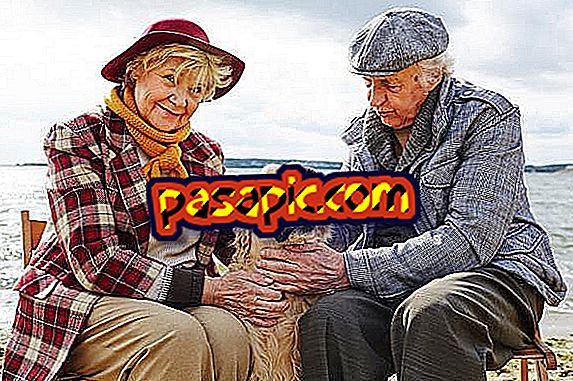Symptoms of old age in dogs

Dogs, like humans, go through different stages throughout their lives. The difference between the two is that dogs have a shorter life expectancy than people, so their stages are shorter. Anyone who has had a dog since he was a puppy will know how nice it is to see how he grows and develops the attitudes and behaviors that make him different from everyone else. Also, there comes a day when we can ask ourselves if we can consider our old dog or if he will be in his old age. The truth is that this varies depending on different factors that we explain below in this article of .com in which we talk about the symptoms of old age in dogs .
Factors that influence a dog's old age
There are a variety of breeds of dogs and even many of them do not have an exact breed because they come from different crosses. This is why it can be difficult to decide when a dog is old, and the truth is that it depends on different factors, both those of the dog and some external factors that can affect their quality of life. Therefore, before starting to talk about the symptoms of old age of dogs, we will briefly review the factors that can influence:
- Race Each race has common physical and mental characteristics, although each dog, individually, can have its differences that makes it unique. Some breeds are more likely to develop certain types of diseases that can harm their health and shorten their life expectancy.
- The size There are different dogs depending on their size, and this factor can also influence when a dog is in its old age. So, for example, dogs of small and medium breed are usually grandparents from 10-11 years, while those of large or giant race reach this stage at 7 or 8 years.
- Quality of life Despite the average life we can know of each breed, a dog can have a shorter life expectancy depending on the care it has received: a good diet, adequate physical activity, a proper socialization, has visited the veterinarian periodically, etc.

Less desire to walk
Everyone who has a dog knows how he enjoys going for a walk. It is one of the moments of the day that our furry friends most expect, since they can be in contact with other dogs, sniff, see other people, and perform physical activity. While there are dogs with more energy than others, everyone should go out for a walk every day. Therefore, one of the symptoms of old age in dogs is the loss of interest in physical activity . This symptom is due to the fact that your dog feels more tired, so he does not feel the energy that he had before running all over his body. Now, instead of going for a run, you may prefer to lie on your bed, or snuggle with you in search of caresses.

Less agility
Related to the previous point, another symptom that your dog may be old is a loss of agility and greater difficulty in moving. This fact is more evident when our dog tries to go up or down stairs or when we try to play with it, since we can see how it gets tired earlier or that it loses interest more easily, besides being able to detect that it moves with more difficulty. There is no reason to worry if we detect this symptom of old age in our dog, since it is something natural and inevitable. However, it is important to take the veterinarian if we detect that you have problems moving, since in some cases it could be canine osteoarthritis. Unless the veterinarian tells you otherwise, try to keep your dog moving and exercising, even if it is less intense.
In this article we explain when to take your dog to the vet.

Weight gain or loss
When our faithful friend begins to enter the third age can inexplicably gain weight or, on the contrary, experience a loss of weight. The truth is that it is more frequent that the first happens, since the loss of interest in walking caused by greater fatigue, along with loss of agility and movement reduce their physical activity. As a result, one of the symptoms of old age in dogs that we can detect is that they gain a few kilos. When this happens, the most frequent thing is that we have to change their diet, since the nutritional needs of dogs at this stage can change. Therefore, once again it is important to request the help of the veterinarian, in order to recommend the most appropriate type of food so that our dog does not fatten.

Eye problems
Another effect of time on our dog is the loss of vision or other eye problems. When our dog is old, we may detect some symptoms such as stumbling, being hit with objects when walking, in addition to having eyes in their eyes or that they are red. Sometimes, it is only a conjunctivis or dry eyes, something that can be easily solved. However, in other cases it may be that our dog is losing sight or suffering from cataracts and has a greater difficulty to perceive their environment and move without difficulty. In case of detecting this symptom of old age in our dog it is important to go to the veterinarian for a checkup.

Mouth problems
In general, this type of problems usually derive from poor care throughout the life of our dog. Oral hygiene is one of the aspects that we can forget in the care of our furry friend, but it is important to save problems in old age. Therefore, if we have not provided optimal oral care, another of the symptoms that we can observe of old age in dogs is bad breath, bleeding and inflammation of the gums or the loss of a tooth. In fact, a dog that is in good health has pink gums, while a dog that enters the third age will have darker.
In this video we show you how to brush the dog's teeth.
Signs in the skin
Other signs that can indicate that a dog is in old age is the presence of bumps or other signs on the skin like gray hair, something very common. You may detect some kind of trace on the skin, such as hair loss, the appearance of a lump that was not there before. Also, a dog that is in its old age can also develop rashes, inflammations, wounds or dry skin . This type of symptoms that indicate that our dog is in old age can be treated with appropriate products, such as shampoos, soaps, lotions, in addition to a proper diet. Go to the veterinarian to check the skin of your dog and inform you about the problem and possible treatment.
Also, in this article we explain how to care for an old dog.



